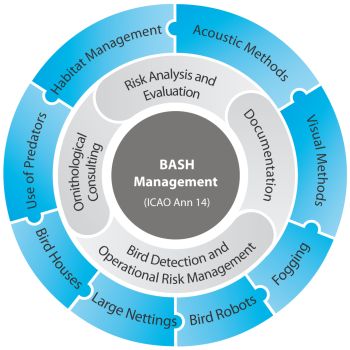
Airports give birds plenty of space to breed and roost. On an airfield, birds can easily spot their enemies. Also, airfields emit heat which attracts birds. Especially on airfields, birds pose a serious risk to airplanes. Should they get into the turbines during take-off or landing, they can even crash a plane in the worst scenario.
It is important to take a holistic approach towards bird control at airports. This means to cover attractive spots at buildings and also the airstrips itself.
1. Bird Control at Airport Buildings
2. Airside Bird Control
3. Bird Control Training and Management System
Please download our Catalogue for Airports here.
1. Bird Control at Airport Buildings
Birds can find many places around an airport to breed and roost. If birds should be kept away from an airport area, breeding must be prevented. If this is not possible, the bird will always return to the place of successful breeding - including next generations.

At airport buildings, we mainly focus on attics of hangars, where birds usually sit, before flying into them. Protecting these attics with electrical systems is highly effective, since birds receive an harmless, but painful electric shock, which they memorize.
But we also offer all other bird control systems for hangars.


Hangars should be netted in order to prevent birds from breeding.
2. Airside Bird Control
Most bird strike events happen in the first 800 meters. This is why bird control efforts concentrate on airports and airport surrounding.An important instrument for an early detection of dangerous birds are Birdradars. Modern software algorithms can filter the echo signals and even measure the mass of the bird in the air. Applying this algorithm make it possible to distinguish a flock of birds, which is exceeding the critical mass, from a harmless flock.
und der Flash Player installiert sein.
These software algorithms can also anticipate the flying path of the birds and calculate a collision probability with an airplane. When this probability exceeds a critical level, a warning signal is automatically issued to the ATC (Air Traffic Control). This technology allow a next level of modern risk management (Operational Risk Management) of bird strike risk in commercial and military aviation.
We offer a wide variety of bird dispersal techniques for BCU airport personnel. As birds often habituate to a certain method, it makes sense to combine several methods and rotate them eerratically.
For more information, please click on the link http://www.birdstrike.de/index.en.php or on the following graph:
3. Bird Control Training and Management System
This system has been designed to train airport personnel on bird control techniques and routines. The system contains:- Bird control standards and regulations
- Techniques and technologies to deter birds
- Identification of most common birds in the respective area
- BCU routines
and much more.
The Management-Tool enables airport management to manage their BCU team, monitor the bird control infrastructure of the airport, analyse statistics of most common birds and much more.
Please request your test account for our system today!







